Assessment: identify the key aspects of the clinical scenario
VerifiedAdded on 2022/11/23
|11
|2940
|1
AI Summary
Contribute Materials
Your contribution can guide someone’s learning journey. Share your
documents today.
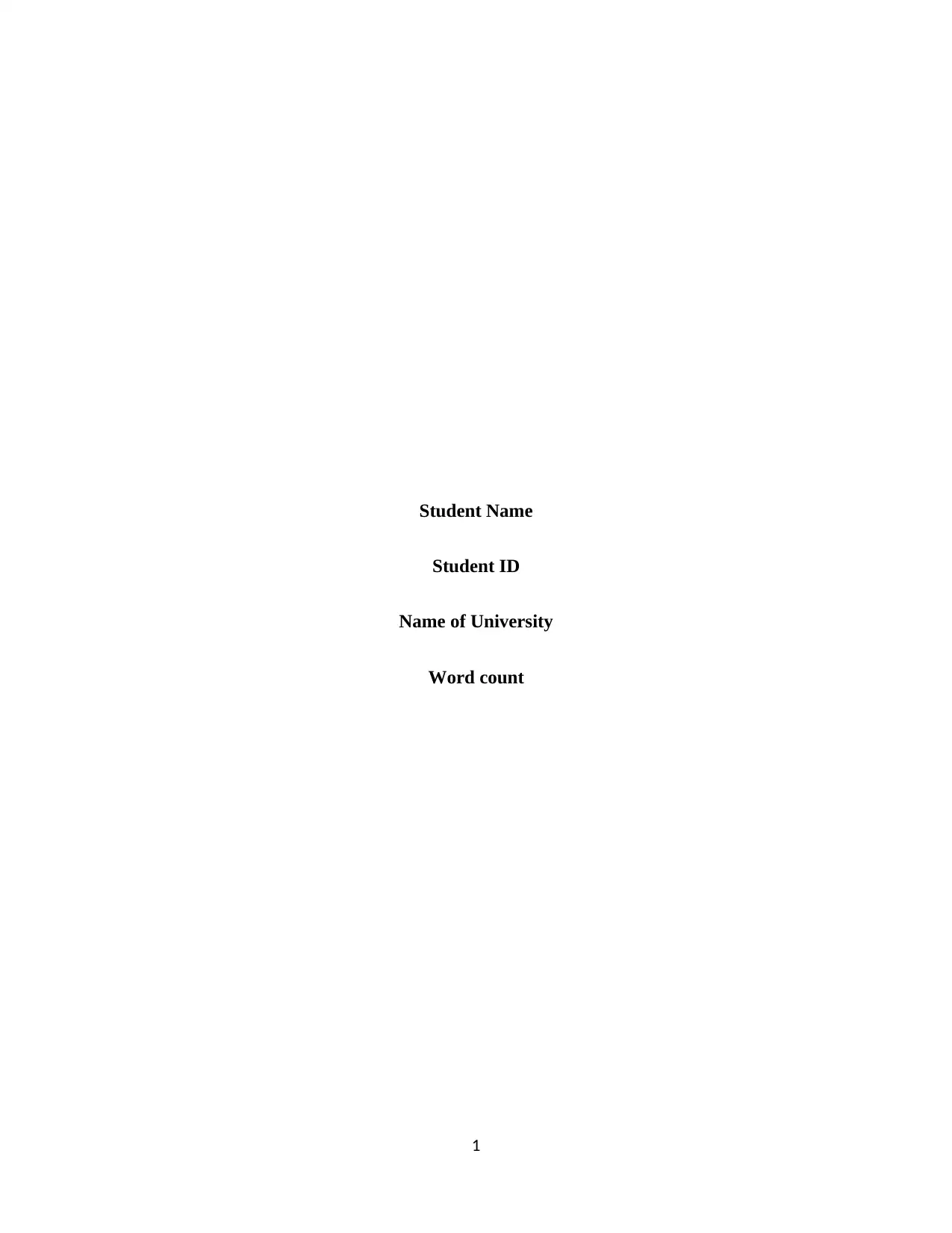
Student Name
Student ID
Name of University
Word count
1
Student ID
Name of University
Word count
1
Secure Best Marks with AI Grader
Need help grading? Try our AI Grader for instant feedback on your assignments.
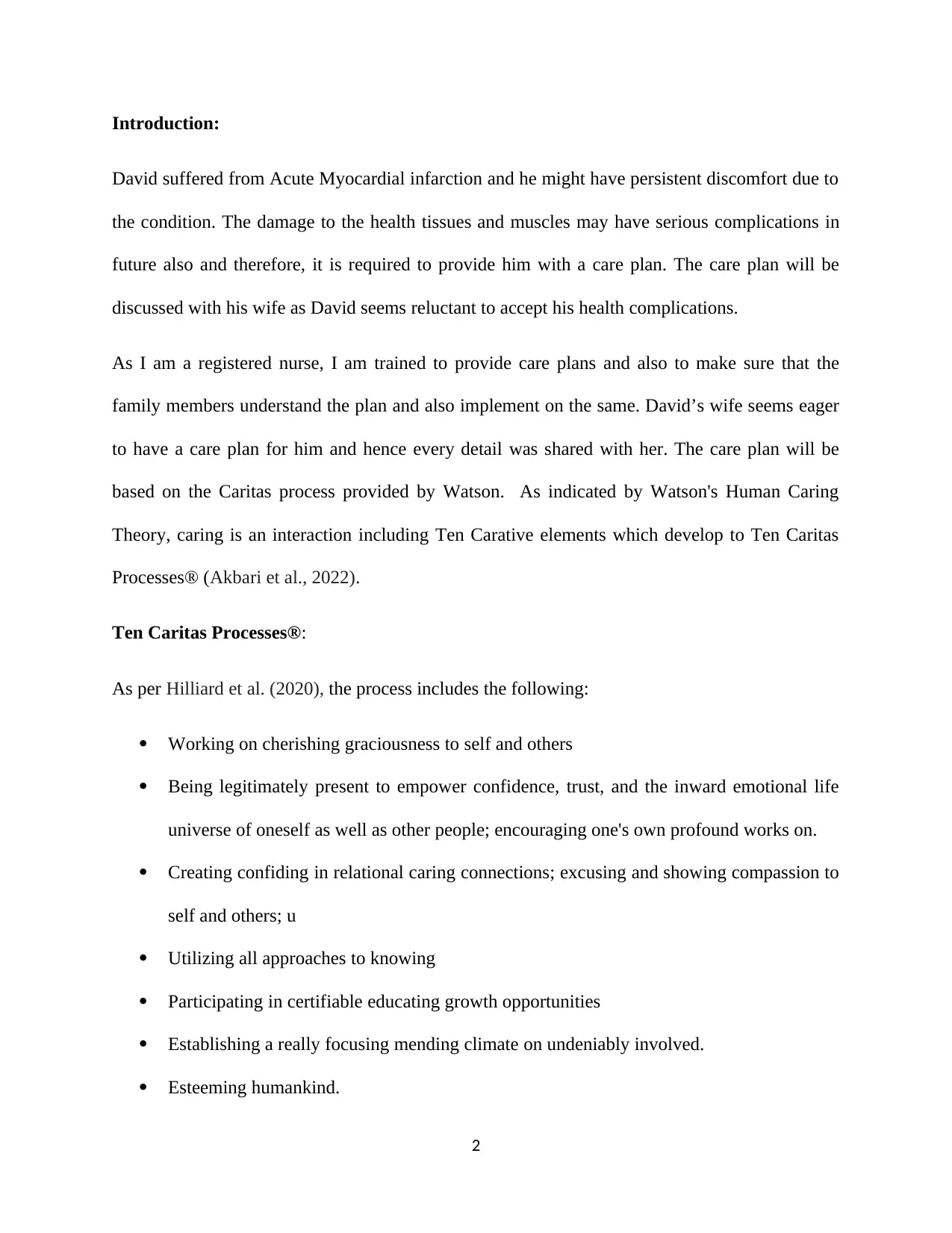
Introduction:
David suffered from Acute Myocardial infarction and he might have persistent discomfort due to
the condition. The damage to the health tissues and muscles may have serious complications in
future also and therefore, it is required to provide him with a care plan. The care plan will be
discussed with his wife as David seems reluctant to accept his health complications.
As I am a registered nurse, I am trained to provide care plans and also to make sure that the
family members understand the plan and also implement on the same. David’s wife seems eager
to have a care plan for him and hence every detail was shared with her. The care plan will be
based on the Caritas process provided by Watson. As indicated by Watson's Human Caring
Theory, caring is an interaction including Ten Carative elements which develop to Ten Caritas
Processes® (Akbari et al., 2022).
Ten Caritas Processes®:
As per Hilliard et al. (2020), the process includes the following:
Working on cherishing graciousness to self and others
Being legitimately present to empower confidence, trust, and the inward emotional life
universe of oneself as well as other people; encouraging one's own profound works on.
Creating confiding in relational caring connections; excusing and showing compassion to
self and others; u
Utilizing all approaches to knowing
Participating in certifiable educating growth opportunities
Establishing a really focusing mending climate on undeniably involved.
Esteeming humankind.
2
David suffered from Acute Myocardial infarction and he might have persistent discomfort due to
the condition. The damage to the health tissues and muscles may have serious complications in
future also and therefore, it is required to provide him with a care plan. The care plan will be
discussed with his wife as David seems reluctant to accept his health complications.
As I am a registered nurse, I am trained to provide care plans and also to make sure that the
family members understand the plan and also implement on the same. David’s wife seems eager
to have a care plan for him and hence every detail was shared with her. The care plan will be
based on the Caritas process provided by Watson. As indicated by Watson's Human Caring
Theory, caring is an interaction including Ten Carative elements which develop to Ten Caritas
Processes® (Akbari et al., 2022).
Ten Caritas Processes®:
As per Hilliard et al. (2020), the process includes the following:
Working on cherishing graciousness to self and others
Being legitimately present to empower confidence, trust, and the inward emotional life
universe of oneself as well as other people; encouraging one's own profound works on.
Creating confiding in relational caring connections; excusing and showing compassion to
self and others; u
Utilizing all approaches to knowing
Participating in certifiable educating growth opportunities
Establishing a really focusing mending climate on undeniably involved.
Esteeming humankind.
2
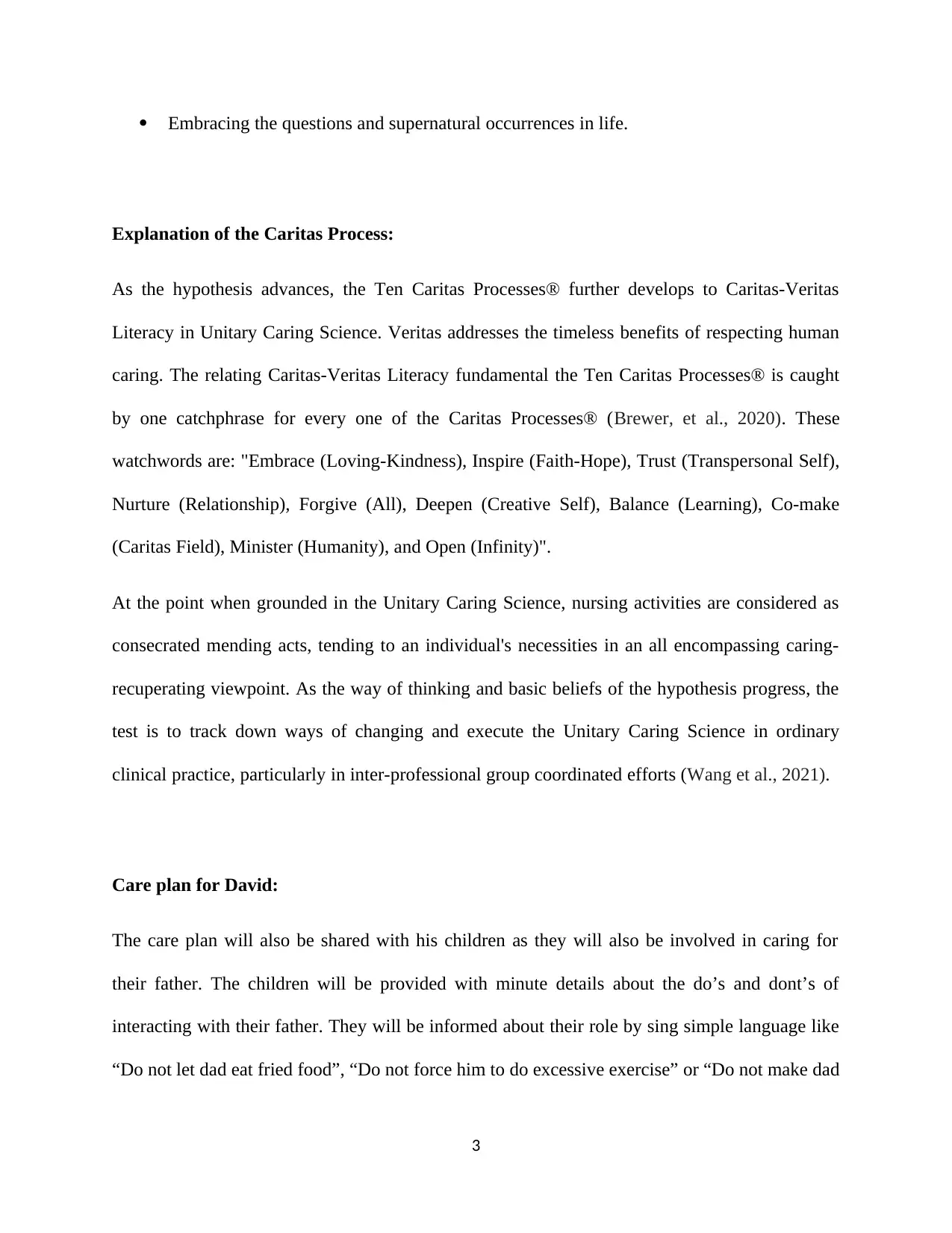
Embracing the questions and supernatural occurrences in life.
Explanation of the Caritas Process:
As the hypothesis advances, the Ten Caritas Processes® further develops to Caritas-Veritas
Literacy in Unitary Caring Science. Veritas addresses the timeless benefits of respecting human
caring. The relating Caritas-Veritas Literacy fundamental the Ten Caritas Processes® is caught
by one catchphrase for every one of the Caritas Processes® (Brewer, et al., 2020). These
watchwords are: "Embrace (Loving-Kindness), Inspire (Faith-Hope), Trust (Transpersonal Self),
Nurture (Relationship), Forgive (All), Deepen (Creative Self), Balance (Learning), Co-make
(Caritas Field), Minister (Humanity), and Open (Infinity)".
At the point when grounded in the Unitary Caring Science, nursing activities are considered as
consecrated mending acts, tending to an individual's necessities in an all encompassing caring-
recuperating viewpoint. As the way of thinking and basic beliefs of the hypothesis progress, the
test is to track down ways of changing and execute the Unitary Caring Science in ordinary
clinical practice, particularly in inter-professional group coordinated efforts (Wang et al., 2021).
Care plan for David:
The care plan will also be shared with his children as they will also be involved in caring for
their father. The children will be provided with minute details about the do’s and dont’s of
interacting with their father. They will be informed about their role by sing simple language like
“Do not let dad eat fried food”, “Do not force him to do excessive exercise” or “Do not make dad
3
Explanation of the Caritas Process:
As the hypothesis advances, the Ten Caritas Processes® further develops to Caritas-Veritas
Literacy in Unitary Caring Science. Veritas addresses the timeless benefits of respecting human
caring. The relating Caritas-Veritas Literacy fundamental the Ten Caritas Processes® is caught
by one catchphrase for every one of the Caritas Processes® (Brewer, et al., 2020). These
watchwords are: "Embrace (Loving-Kindness), Inspire (Faith-Hope), Trust (Transpersonal Self),
Nurture (Relationship), Forgive (All), Deepen (Creative Self), Balance (Learning), Co-make
(Caritas Field), Minister (Humanity), and Open (Infinity)".
At the point when grounded in the Unitary Caring Science, nursing activities are considered as
consecrated mending acts, tending to an individual's necessities in an all encompassing caring-
recuperating viewpoint. As the way of thinking and basic beliefs of the hypothesis progress, the
test is to track down ways of changing and execute the Unitary Caring Science in ordinary
clinical practice, particularly in inter-professional group coordinated efforts (Wang et al., 2021).
Care plan for David:
The care plan will also be shared with his children as they will also be involved in caring for
their father. The children will be provided with minute details about the do’s and dont’s of
interacting with their father. They will be informed about their role by sing simple language like
“Do not let dad eat fried food”, “Do not force him to do excessive exercise” or “Do not make dad
3
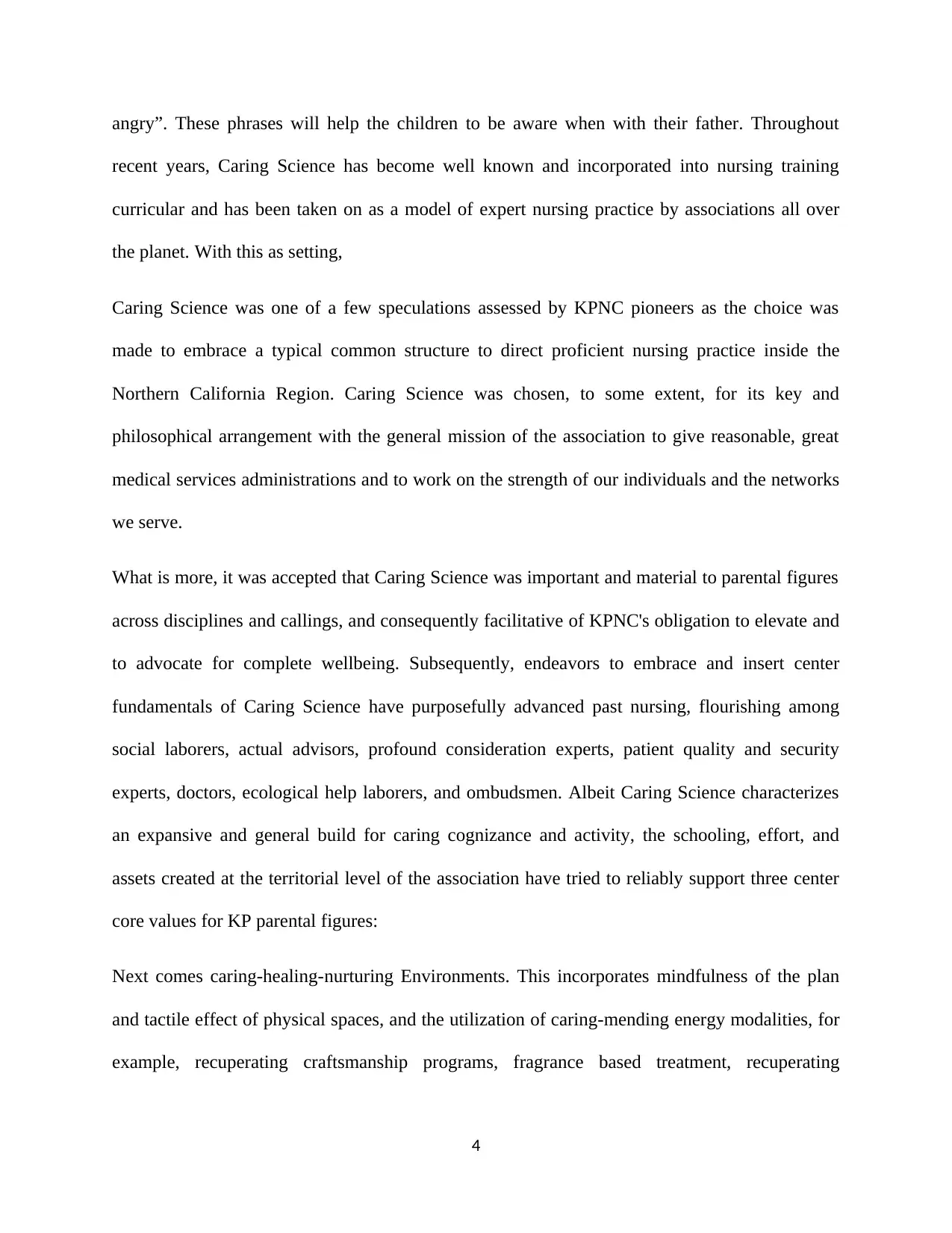
angry”. These phrases will help the children to be aware when with their father. Throughout
recent years, Caring Science has become well known and incorporated into nursing training
curricular and has been taken on as a model of expert nursing practice by associations all over
the planet. With this as setting,
Caring Science was one of a few speculations assessed by KPNC pioneers as the choice was
made to embrace a typical common structure to direct proficient nursing practice inside the
Northern California Region. Caring Science was chosen, to some extent, for its key and
philosophical arrangement with the general mission of the association to give reasonable, great
medical services administrations and to work on the strength of our individuals and the networks
we serve.
What is more, it was accepted that Caring Science was important and material to parental figures
across disciplines and callings, and consequently facilitative of KPNC's obligation to elevate and
to advocate for complete wellbeing. Subsequently, endeavors to embrace and insert center
fundamentals of Caring Science have purposefully advanced past nursing, flourishing among
social laborers, actual advisors, profound consideration experts, patient quality and security
experts, doctors, ecological help laborers, and ombudsmen. Albeit Caring Science characterizes
an expansive and general build for caring cognizance and activity, the schooling, effort, and
assets created at the territorial level of the association have tried to reliably support three center
core values for KP parental figures:
Next comes caring-healing-nurturing Environments. This incorporates mindfulness of the plan
and tactile effect of physical spaces, and the utilization of caring-mending energy modalities, for
example, recuperating craftsmanship programs, fragrance based treatment, recuperating
4
recent years, Caring Science has become well known and incorporated into nursing training
curricular and has been taken on as a model of expert nursing practice by associations all over
the planet. With this as setting,
Caring Science was one of a few speculations assessed by KPNC pioneers as the choice was
made to embrace a typical common structure to direct proficient nursing practice inside the
Northern California Region. Caring Science was chosen, to some extent, for its key and
philosophical arrangement with the general mission of the association to give reasonable, great
medical services administrations and to work on the strength of our individuals and the networks
we serve.
What is more, it was accepted that Caring Science was important and material to parental figures
across disciplines and callings, and consequently facilitative of KPNC's obligation to elevate and
to advocate for complete wellbeing. Subsequently, endeavors to embrace and insert center
fundamentals of Caring Science have purposefully advanced past nursing, flourishing among
social laborers, actual advisors, profound consideration experts, patient quality and security
experts, doctors, ecological help laborers, and ombudsmen. Albeit Caring Science characterizes
an expansive and general build for caring cognizance and activity, the schooling, effort, and
assets created at the territorial level of the association have tried to reliably support three center
core values for KP parental figures:
Next comes caring-healing-nurturing Environments. This incorporates mindfulness of the plan
and tactile effect of physical spaces, and the utilization of caring-mending energy modalities, for
example, recuperating craftsmanship programs, fragrance based treatment, recuperating
4
Secure Best Marks with AI Grader
Need help grading? Try our AI Grader for instant feedback on your assignments.
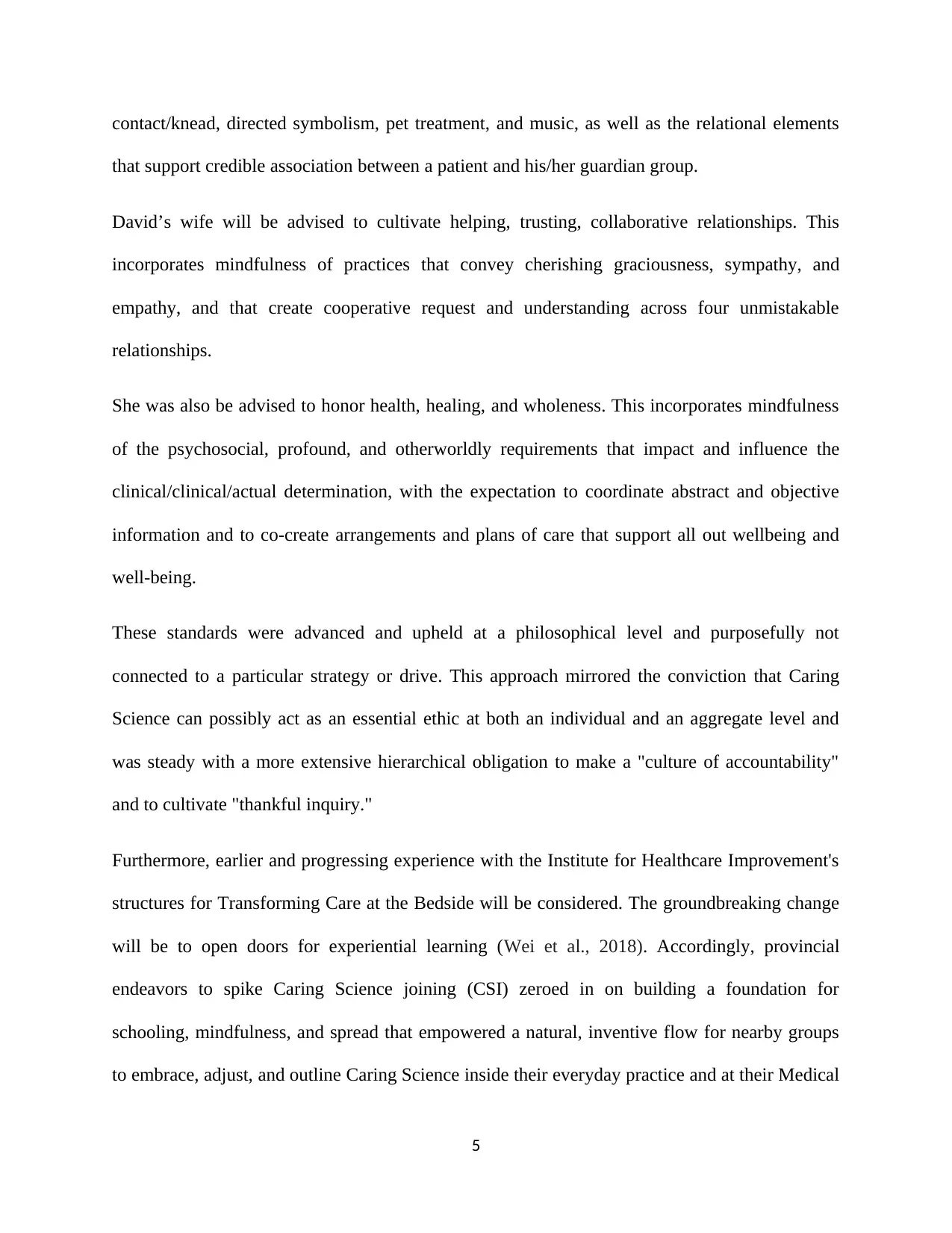
contact/knead, directed symbolism, pet treatment, and music, as well as the relational elements
that support credible association between a patient and his/her guardian group.
David’s wife will be advised to cultivate helping, trusting, collaborative relationships. This
incorporates mindfulness of practices that convey cherishing graciousness, sympathy, and
empathy, and that create cooperative request and understanding across four unmistakable
relationships.
She was also be advised to honor health, healing, and wholeness. This incorporates mindfulness
of the psychosocial, profound, and otherworldly requirements that impact and influence the
clinical/clinical/actual determination, with the expectation to coordinate abstract and objective
information and to co-create arrangements and plans of care that support all out wellbeing and
well-being.
These standards were advanced and upheld at a philosophical level and purposefully not
connected to a particular strategy or drive. This approach mirrored the conviction that Caring
Science can possibly act as an essential ethic at both an individual and an aggregate level and
was steady with a more extensive hierarchical obligation to make a "culture of accountability"
and to cultivate "thankful inquiry."
Furthermore, earlier and progressing experience with the Institute for Healthcare Improvement's
structures for Transforming Care at the Bedside will be considered. The groundbreaking change
will be to open doors for experiential learning (Wei et al., 2018). Accordingly, provincial
endeavors to spike Caring Science joining (CSI) zeroed in on building a foundation for
schooling, mindfulness, and spread that empowered a natural, inventive flow for nearby groups
to embrace, adjust, and outline Caring Science inside their everyday practice and at their Medical
5
that support credible association between a patient and his/her guardian group.
David’s wife will be advised to cultivate helping, trusting, collaborative relationships. This
incorporates mindfulness of practices that convey cherishing graciousness, sympathy, and
empathy, and that create cooperative request and understanding across four unmistakable
relationships.
She was also be advised to honor health, healing, and wholeness. This incorporates mindfulness
of the psychosocial, profound, and otherworldly requirements that impact and influence the
clinical/clinical/actual determination, with the expectation to coordinate abstract and objective
information and to co-create arrangements and plans of care that support all out wellbeing and
well-being.
These standards were advanced and upheld at a philosophical level and purposefully not
connected to a particular strategy or drive. This approach mirrored the conviction that Caring
Science can possibly act as an essential ethic at both an individual and an aggregate level and
was steady with a more extensive hierarchical obligation to make a "culture of accountability"
and to cultivate "thankful inquiry."
Furthermore, earlier and progressing experience with the Institute for Healthcare Improvement's
structures for Transforming Care at the Bedside will be considered. The groundbreaking change
will be to open doors for experiential learning (Wei et al., 2018). Accordingly, provincial
endeavors to spike Caring Science joining (CSI) zeroed in on building a foundation for
schooling, mindfulness, and spread that empowered a natural, inventive flow for nearby groups
to embrace, adjust, and outline Caring Science inside their everyday practice and at their Medical
5
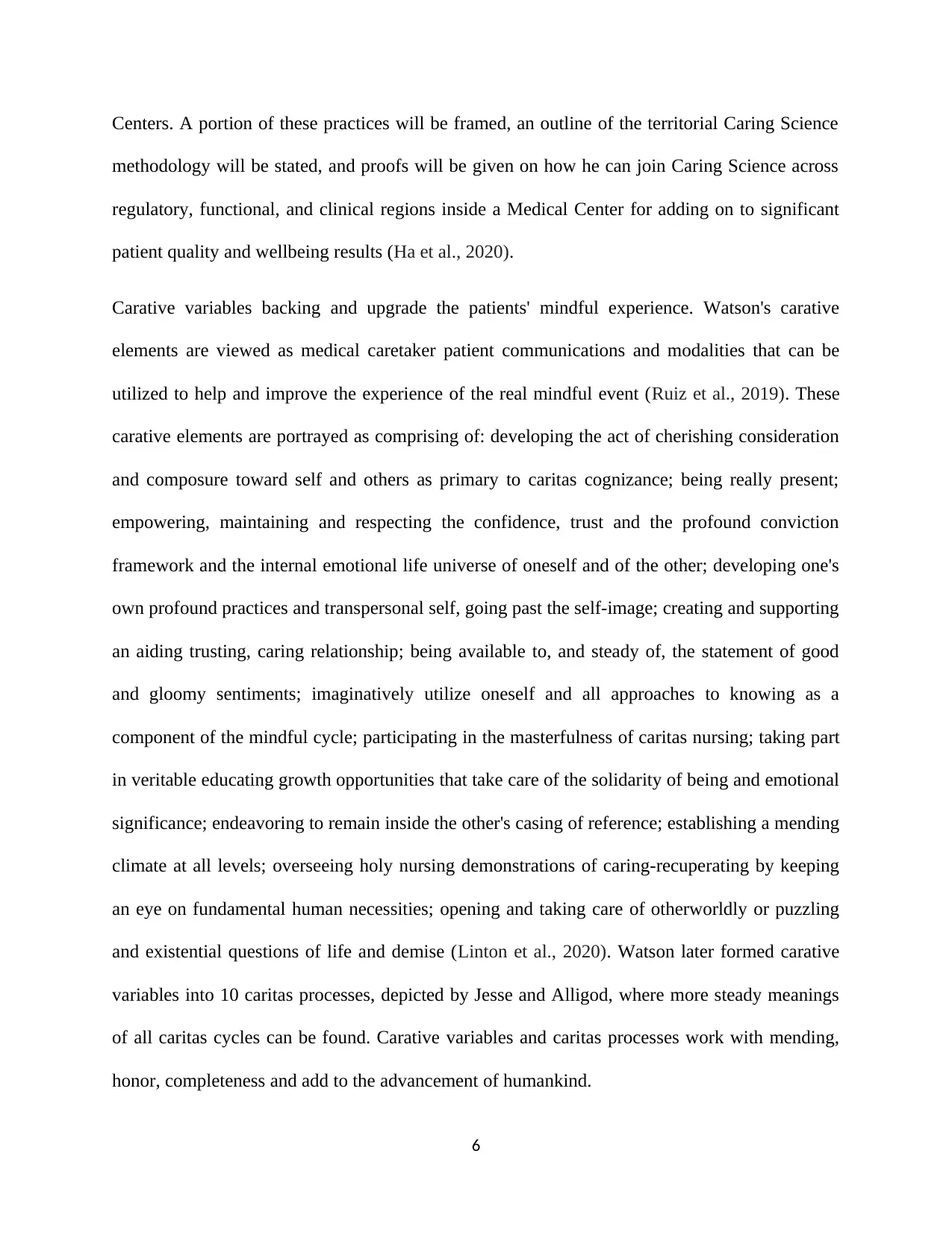
Centers. A portion of these practices will be framed, an outline of the territorial Caring Science
methodology will be stated, and proofs will be given on how he can join Caring Science across
regulatory, functional, and clinical regions inside a Medical Center for adding on to significant
patient quality and wellbeing results (Ha et al., 2020).
Carative variables backing and upgrade the patients' mindful experience. Watson's carative
elements are viewed as medical caretaker patient communications and modalities that can be
utilized to help and improve the experience of the real mindful event (Ruiz et al., 2019). These
carative elements are portrayed as comprising of: developing the act of cherishing consideration
and composure toward self and others as primary to caritas cognizance; being really present;
empowering, maintaining and respecting the confidence, trust and the profound conviction
framework and the internal emotional life universe of oneself and of the other; developing one's
own profound practices and transpersonal self, going past the self-image; creating and supporting
an aiding trusting, caring relationship; being available to, and steady of, the statement of good
and gloomy sentiments; imaginatively utilize oneself and all approaches to knowing as a
component of the mindful cycle; participating in the masterfulness of caritas nursing; taking part
in veritable educating growth opportunities that take care of the solidarity of being and emotional
significance; endeavoring to remain inside the other's casing of reference; establishing a mending
climate at all levels; overseeing holy nursing demonstrations of caring-recuperating by keeping
an eye on fundamental human necessities; opening and taking care of otherworldly or puzzling
and existential questions of life and demise (Linton et al., 2020). Watson later formed carative
variables into 10 caritas processes, depicted by Jesse and Alligod, where more steady meanings
of all caritas cycles can be found. Carative variables and caritas processes work with mending,
honor, completeness and add to the advancement of humankind.
6
methodology will be stated, and proofs will be given on how he can join Caring Science across
regulatory, functional, and clinical regions inside a Medical Center for adding on to significant
patient quality and wellbeing results (Ha et al., 2020).
Carative variables backing and upgrade the patients' mindful experience. Watson's carative
elements are viewed as medical caretaker patient communications and modalities that can be
utilized to help and improve the experience of the real mindful event (Ruiz et al., 2019). These
carative elements are portrayed as comprising of: developing the act of cherishing consideration
and composure toward self and others as primary to caritas cognizance; being really present;
empowering, maintaining and respecting the confidence, trust and the profound conviction
framework and the internal emotional life universe of oneself and of the other; developing one's
own profound practices and transpersonal self, going past the self-image; creating and supporting
an aiding trusting, caring relationship; being available to, and steady of, the statement of good
and gloomy sentiments; imaginatively utilize oneself and all approaches to knowing as a
component of the mindful cycle; participating in the masterfulness of caritas nursing; taking part
in veritable educating growth opportunities that take care of the solidarity of being and emotional
significance; endeavoring to remain inside the other's casing of reference; establishing a mending
climate at all levels; overseeing holy nursing demonstrations of caring-recuperating by keeping
an eye on fundamental human necessities; opening and taking care of otherworldly or puzzling
and existential questions of life and demise (Linton et al., 2020). Watson later formed carative
variables into 10 caritas processes, depicted by Jesse and Alligod, where more steady meanings
of all caritas cycles can be found. Carative variables and caritas processes work with mending,
honor, completeness and add to the advancement of humankind.
6
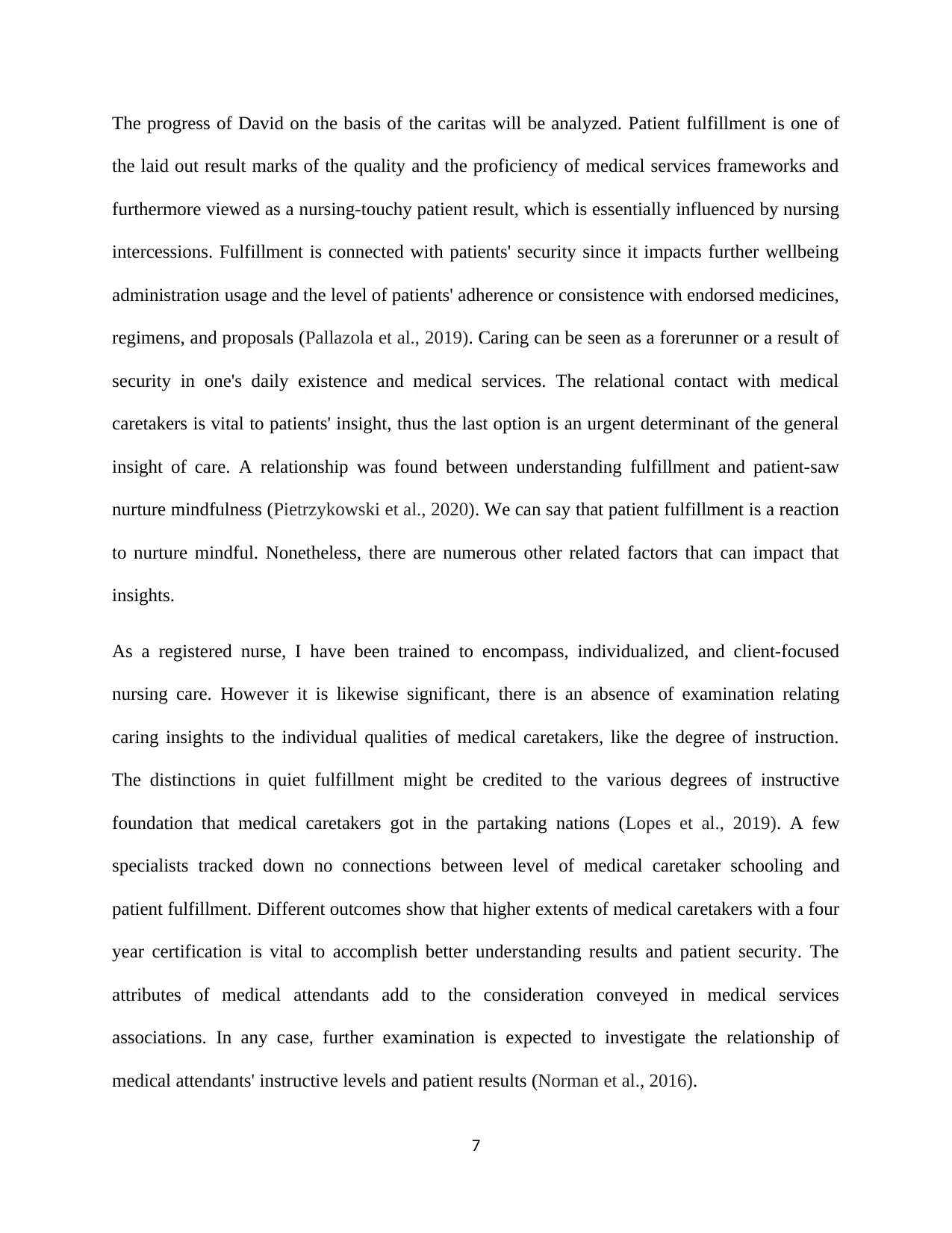
The progress of David on the basis of the caritas will be analyzed. Patient fulfillment is one of
the laid out result marks of the quality and the proficiency of medical services frameworks and
furthermore viewed as a nursing-touchy patient result, which is essentially influenced by nursing
intercessions. Fulfillment is connected with patients' security since it impacts further wellbeing
administration usage and the level of patients' adherence or consistence with endorsed medicines,
regimens, and proposals (Pallazola et al., 2019). Caring can be seen as a forerunner or a result of
security in one's daily existence and medical services. The relational contact with medical
caretakers is vital to patients' insight, thus the last option is an urgent determinant of the general
insight of care. A relationship was found between understanding fulfillment and patient-saw
nurture mindfulness (Pietrzykowski et al., 2020). We can say that patient fulfillment is a reaction
to nurture mindful. Nonetheless, there are numerous other related factors that can impact that
insights.
As a registered nurse, I have been trained to encompass, individualized, and client-focused
nursing care. However it is likewise significant, there is an absence of examination relating
caring insights to the individual qualities of medical caretakers, like the degree of instruction.
The distinctions in quiet fulfillment might be credited to the various degrees of instructive
foundation that medical caretakers got in the partaking nations (Lopes et al., 2019). A few
specialists tracked down no connections between level of medical caretaker schooling and
patient fulfillment. Different outcomes show that higher extents of medical caretakers with a four
year certification is vital to accomplish better understanding results and patient security. The
attributes of medical attendants add to the consideration conveyed in medical services
associations. In any case, further examination is expected to investigate the relationship of
medical attendants' instructive levels and patient results (Norman et al., 2016).
7
the laid out result marks of the quality and the proficiency of medical services frameworks and
furthermore viewed as a nursing-touchy patient result, which is essentially influenced by nursing
intercessions. Fulfillment is connected with patients' security since it impacts further wellbeing
administration usage and the level of patients' adherence or consistence with endorsed medicines,
regimens, and proposals (Pallazola et al., 2019). Caring can be seen as a forerunner or a result of
security in one's daily existence and medical services. The relational contact with medical
caretakers is vital to patients' insight, thus the last option is an urgent determinant of the general
insight of care. A relationship was found between understanding fulfillment and patient-saw
nurture mindfulness (Pietrzykowski et al., 2020). We can say that patient fulfillment is a reaction
to nurture mindful. Nonetheless, there are numerous other related factors that can impact that
insights.
As a registered nurse, I have been trained to encompass, individualized, and client-focused
nursing care. However it is likewise significant, there is an absence of examination relating
caring insights to the individual qualities of medical caretakers, like the degree of instruction.
The distinctions in quiet fulfillment might be credited to the various degrees of instructive
foundation that medical caretakers got in the partaking nations (Lopes et al., 2019). A few
specialists tracked down no connections between level of medical caretaker schooling and
patient fulfillment. Different outcomes show that higher extents of medical caretakers with a four
year certification is vital to accomplish better understanding results and patient security. The
attributes of medical attendants add to the consideration conveyed in medical services
associations. In any case, further examination is expected to investigate the relationship of
medical attendants' instructive levels and patient results (Norman et al., 2016).
7
Paraphrase This Document
Need a fresh take? Get an instant paraphrase of this document with our AI Paraphraser
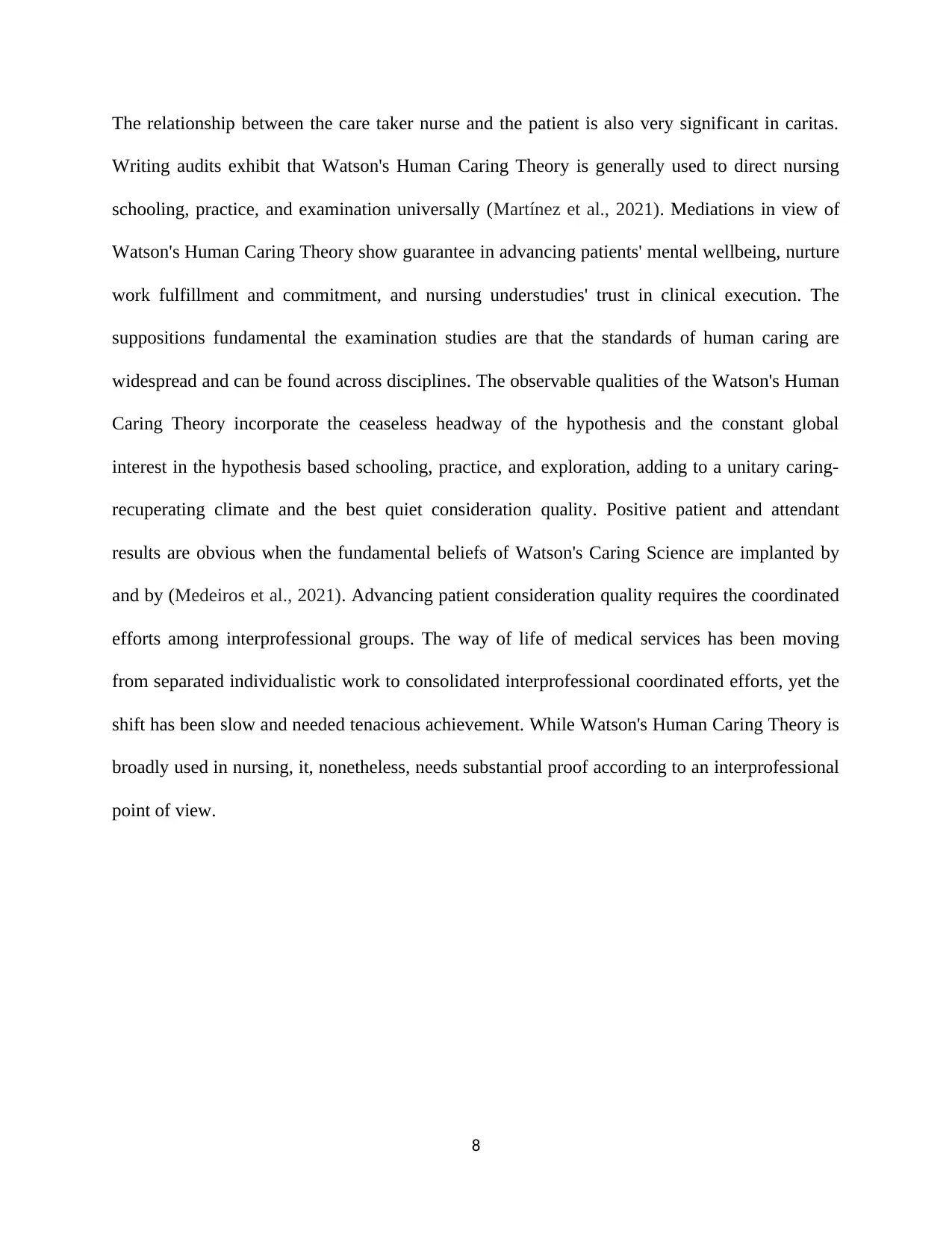
The relationship between the care taker nurse and the patient is also very significant in caritas.
Writing audits exhibit that Watson's Human Caring Theory is generally used to direct nursing
schooling, practice, and examination universally (Martínez et al., 2021). Mediations in view of
Watson's Human Caring Theory show guarantee in advancing patients' mental wellbeing, nurture
work fulfillment and commitment, and nursing understudies' trust in clinical execution. The
suppositions fundamental the examination studies are that the standards of human caring are
widespread and can be found across disciplines. The observable qualities of the Watson's Human
Caring Theory incorporate the ceaseless headway of the hypothesis and the constant global
interest in the hypothesis based schooling, practice, and exploration, adding to a unitary caring-
recuperating climate and the best quiet consideration quality. Positive patient and attendant
results are obvious when the fundamental beliefs of Watson's Caring Science are implanted by
and by (Medeiros et al., 2021). Advancing patient consideration quality requires the coordinated
efforts among interprofessional groups. The way of life of medical services has been moving
from separated individualistic work to consolidated interprofessional coordinated efforts, yet the
shift has been slow and needed tenacious achievement. While Watson's Human Caring Theory is
broadly used in nursing, it, nonetheless, needs substantial proof according to an interprofessional
point of view.
8
Writing audits exhibit that Watson's Human Caring Theory is generally used to direct nursing
schooling, practice, and examination universally (Martínez et al., 2021). Mediations in view of
Watson's Human Caring Theory show guarantee in advancing patients' mental wellbeing, nurture
work fulfillment and commitment, and nursing understudies' trust in clinical execution. The
suppositions fundamental the examination studies are that the standards of human caring are
widespread and can be found across disciplines. The observable qualities of the Watson's Human
Caring Theory incorporate the ceaseless headway of the hypothesis and the constant global
interest in the hypothesis based schooling, practice, and exploration, adding to a unitary caring-
recuperating climate and the best quiet consideration quality. Positive patient and attendant
results are obvious when the fundamental beliefs of Watson's Caring Science are implanted by
and by (Medeiros et al., 2021). Advancing patient consideration quality requires the coordinated
efforts among interprofessional groups. The way of life of medical services has been moving
from separated individualistic work to consolidated interprofessional coordinated efforts, yet the
shift has been slow and needed tenacious achievement. While Watson's Human Caring Theory is
broadly used in nursing, it, nonetheless, needs substantial proof according to an interprofessional
point of view.
8
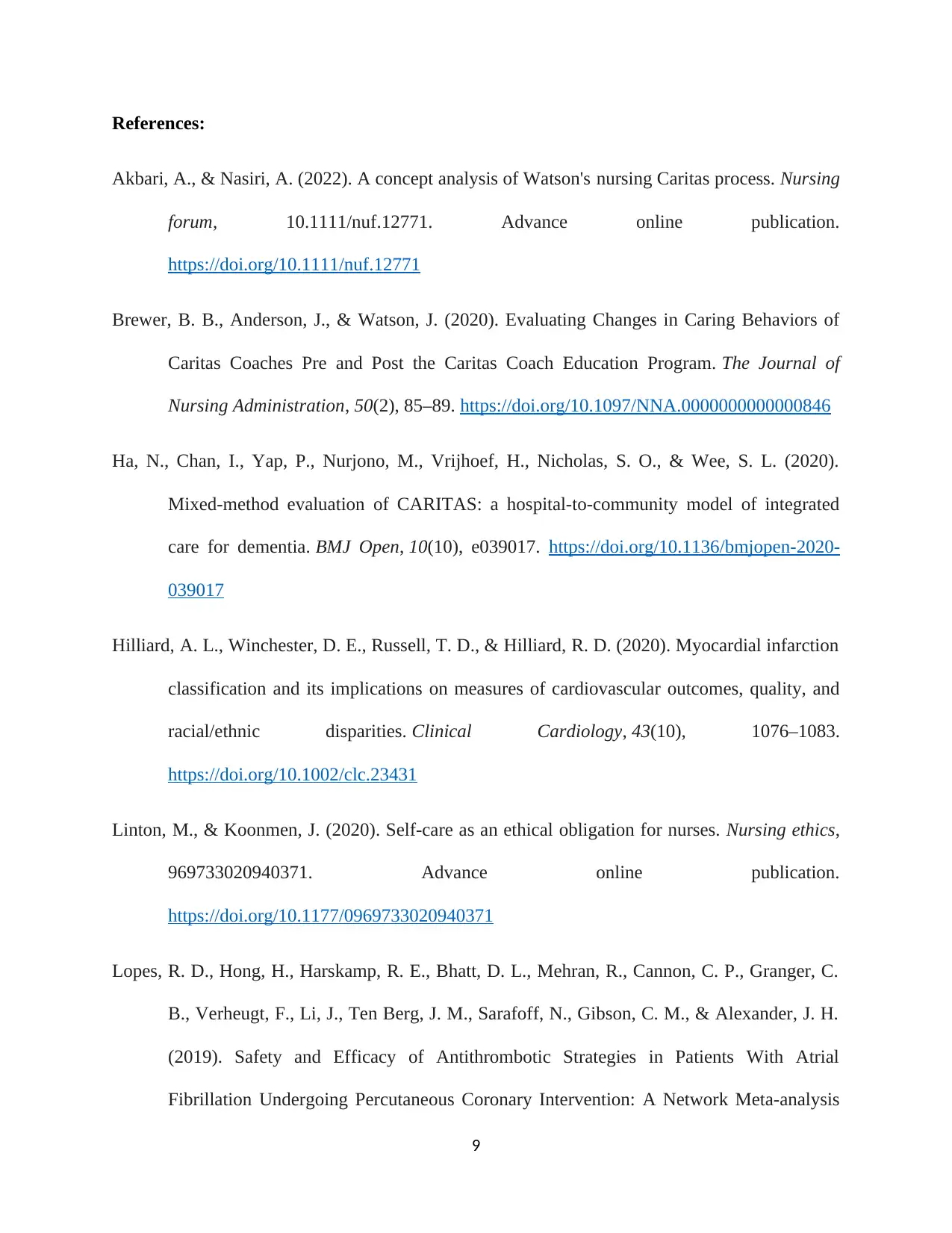
References:
Akbari, A., & Nasiri, A. (2022). A concept analysis of Watson's nursing Caritas process. Nursing
forum, 10.1111/nuf.12771. Advance online publication.
https://doi.org/10.1111/nuf.12771
Brewer, B. B., Anderson, J., & Watson, J. (2020). Evaluating Changes in Caring Behaviors of
Caritas Coaches Pre and Post the Caritas Coach Education Program. The Journal of
Nursing Administration, 50(2), 85–89. https://doi.org/10.1097/NNA.0000000000000846
Ha, N., Chan, I., Yap, P., Nurjono, M., Vrijhoef, H., Nicholas, S. O., & Wee, S. L. (2020).
Mixed-method evaluation of CARITAS: a hospital-to-community model of integrated
care for dementia. BMJ Open, 10(10), e039017. https://doi.org/10.1136/bmjopen-2020-
039017
Hilliard, A. L., Winchester, D. E., Russell, T. D., & Hilliard, R. D. (2020). Myocardial infarction
classification and its implications on measures of cardiovascular outcomes, quality, and
racial/ethnic disparities. Clinical Cardiology, 43(10), 1076–1083.
https://doi.org/10.1002/clc.23431
Linton, M., & Koonmen, J. (2020). Self-care as an ethical obligation for nurses. Nursing ethics,
969733020940371. Advance online publication.
https://doi.org/10.1177/0969733020940371
Lopes, R. D., Hong, H., Harskamp, R. E., Bhatt, D. L., Mehran, R., Cannon, C. P., Granger, C.
B., Verheugt, F., Li, J., Ten Berg, J. M., Sarafoff, N., Gibson, C. M., & Alexander, J. H.
(2019). Safety and Efficacy of Antithrombotic Strategies in Patients With Atrial
Fibrillation Undergoing Percutaneous Coronary Intervention: A Network Meta-analysis
9
Akbari, A., & Nasiri, A. (2022). A concept analysis of Watson's nursing Caritas process. Nursing
forum, 10.1111/nuf.12771. Advance online publication.
https://doi.org/10.1111/nuf.12771
Brewer, B. B., Anderson, J., & Watson, J. (2020). Evaluating Changes in Caring Behaviors of
Caritas Coaches Pre and Post the Caritas Coach Education Program. The Journal of
Nursing Administration, 50(2), 85–89. https://doi.org/10.1097/NNA.0000000000000846
Ha, N., Chan, I., Yap, P., Nurjono, M., Vrijhoef, H., Nicholas, S. O., & Wee, S. L. (2020).
Mixed-method evaluation of CARITAS: a hospital-to-community model of integrated
care for dementia. BMJ Open, 10(10), e039017. https://doi.org/10.1136/bmjopen-2020-
039017
Hilliard, A. L., Winchester, D. E., Russell, T. D., & Hilliard, R. D. (2020). Myocardial infarction
classification and its implications on measures of cardiovascular outcomes, quality, and
racial/ethnic disparities. Clinical Cardiology, 43(10), 1076–1083.
https://doi.org/10.1002/clc.23431
Linton, M., & Koonmen, J. (2020). Self-care as an ethical obligation for nurses. Nursing ethics,
969733020940371. Advance online publication.
https://doi.org/10.1177/0969733020940371
Lopes, R. D., Hong, H., Harskamp, R. E., Bhatt, D. L., Mehran, R., Cannon, C. P., Granger, C.
B., Verheugt, F., Li, J., Ten Berg, J. M., Sarafoff, N., Gibson, C. M., & Alexander, J. H.
(2019). Safety and Efficacy of Antithrombotic Strategies in Patients With Atrial
Fibrillation Undergoing Percutaneous Coronary Intervention: A Network Meta-analysis
9
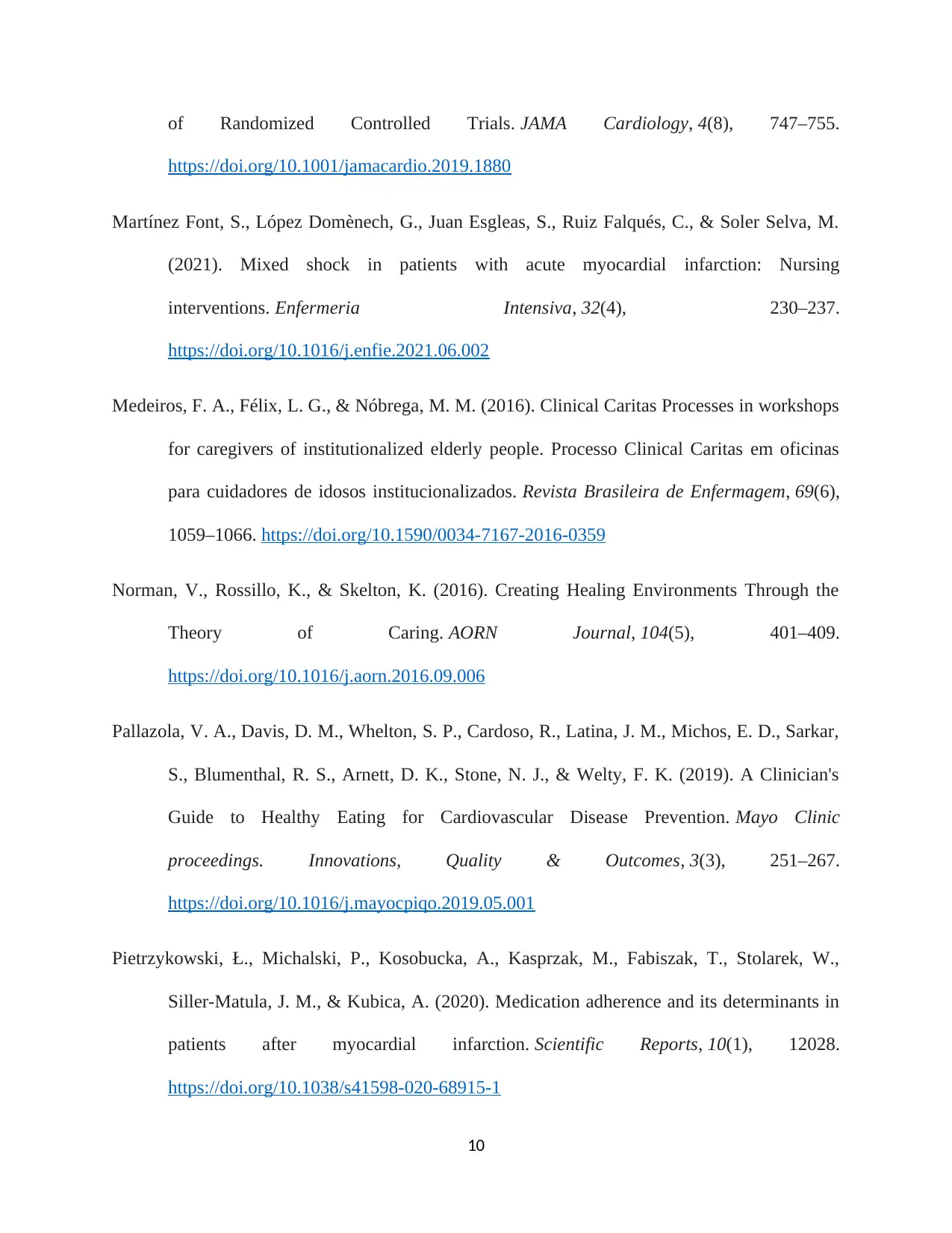
of Randomized Controlled Trials. JAMA Cardiology, 4(8), 747–755.
https://doi.org/10.1001/jamacardio.2019.1880
Martínez Font, S., López Domènech, G., Juan Esgleas, S., Ruiz Falqués, C., & Soler Selva, M.
(2021). Mixed shock in patients with acute myocardial infarction: Nursing
interventions. Enfermeria Intensiva, 32(4), 230–237.
https://doi.org/10.1016/j.enfie.2021.06.002
Medeiros, F. A., Félix, L. G., & Nóbrega, M. M. (2016). Clinical Caritas Processes in workshops
for caregivers of institutionalized elderly people. Processo Clinical Caritas em oficinas
para cuidadores de idosos institucionalizados. Revista Brasileira de Enfermagem, 69(6),
1059–1066. https://doi.org/10.1590/0034-7167-2016-0359
Norman, V., Rossillo, K., & Skelton, K. (2016). Creating Healing Environments Through the
Theory of Caring. AORN Journal, 104(5), 401–409.
https://doi.org/10.1016/j.aorn.2016.09.006
Pallazola, V. A., Davis, D. M., Whelton, S. P., Cardoso, R., Latina, J. M., Michos, E. D., Sarkar,
S., Blumenthal, R. S., Arnett, D. K., Stone, N. J., & Welty, F. K. (2019). A Clinician's
Guide to Healthy Eating for Cardiovascular Disease Prevention. Mayo Clinic
proceedings. Innovations, Quality & Outcomes, 3(3), 251–267.
https://doi.org/10.1016/j.mayocpiqo.2019.05.001
Pietrzykowski, Ł., Michalski, P., Kosobucka, A., Kasprzak, M., Fabiszak, T., Stolarek, W.,
Siller-Matula, J. M., & Kubica, A. (2020). Medication adherence and its determinants in
patients after myocardial infarction. Scientific Reports, 10(1), 12028.
https://doi.org/10.1038/s41598-020-68915-1
10
https://doi.org/10.1001/jamacardio.2019.1880
Martínez Font, S., López Domènech, G., Juan Esgleas, S., Ruiz Falqués, C., & Soler Selva, M.
(2021). Mixed shock in patients with acute myocardial infarction: Nursing
interventions. Enfermeria Intensiva, 32(4), 230–237.
https://doi.org/10.1016/j.enfie.2021.06.002
Medeiros, F. A., Félix, L. G., & Nóbrega, M. M. (2016). Clinical Caritas Processes in workshops
for caregivers of institutionalized elderly people. Processo Clinical Caritas em oficinas
para cuidadores de idosos institucionalizados. Revista Brasileira de Enfermagem, 69(6),
1059–1066. https://doi.org/10.1590/0034-7167-2016-0359
Norman, V., Rossillo, K., & Skelton, K. (2016). Creating Healing Environments Through the
Theory of Caring. AORN Journal, 104(5), 401–409.
https://doi.org/10.1016/j.aorn.2016.09.006
Pallazola, V. A., Davis, D. M., Whelton, S. P., Cardoso, R., Latina, J. M., Michos, E. D., Sarkar,
S., Blumenthal, R. S., Arnett, D. K., Stone, N. J., & Welty, F. K. (2019). A Clinician's
Guide to Healthy Eating for Cardiovascular Disease Prevention. Mayo Clinic
proceedings. Innovations, Quality & Outcomes, 3(3), 251–267.
https://doi.org/10.1016/j.mayocpiqo.2019.05.001
Pietrzykowski, Ł., Michalski, P., Kosobucka, A., Kasprzak, M., Fabiszak, T., Stolarek, W.,
Siller-Matula, J. M., & Kubica, A. (2020). Medication adherence and its determinants in
patients after myocardial infarction. Scientific Reports, 10(1), 12028.
https://doi.org/10.1038/s41598-020-68915-1
10
Secure Best Marks with AI Grader
Need help grading? Try our AI Grader for instant feedback on your assignments.
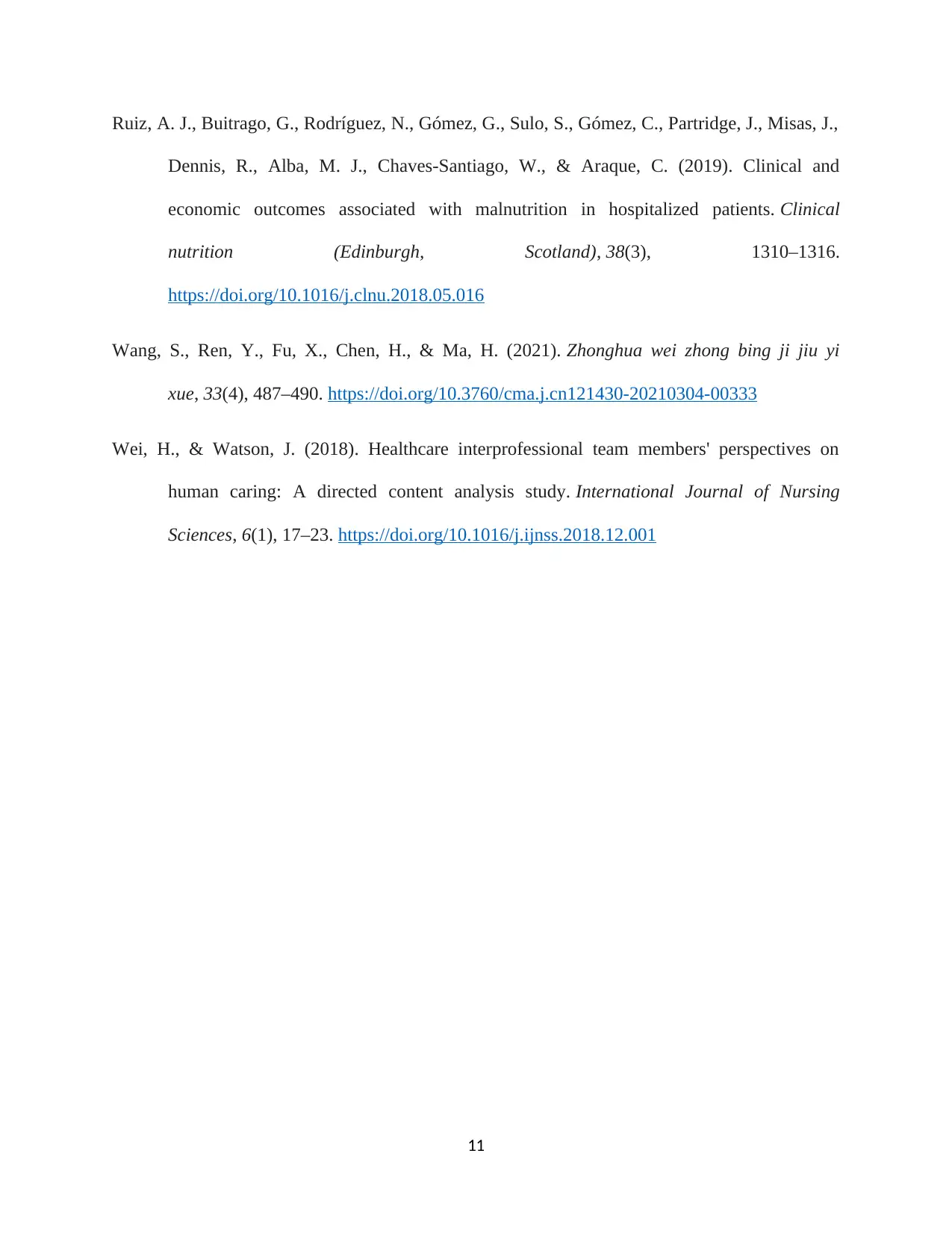
Ruiz, A. J., Buitrago, G., Rodríguez, N., Gómez, G., Sulo, S., Gómez, C., Partridge, J., Misas, J.,
Dennis, R., Alba, M. J., Chaves-Santiago, W., & Araque, C. (2019). Clinical and
economic outcomes associated with malnutrition in hospitalized patients. Clinical
nutrition (Edinburgh, Scotland), 38(3), 1310–1316.
https://doi.org/10.1016/j.clnu.2018.05.016
Wang, S., Ren, Y., Fu, X., Chen, H., & Ma, H. (2021). Zhonghua wei zhong bing ji jiu yi
xue, 33(4), 487–490. https://doi.org/10.3760/cma.j.cn121430-20210304-00333
Wei, H., & Watson, J. (2018). Healthcare interprofessional team members' perspectives on
human caring: A directed content analysis study. International Journal of Nursing
Sciences, 6(1), 17–23. https://doi.org/10.1016/j.ijnss.2018.12.001
11
Dennis, R., Alba, M. J., Chaves-Santiago, W., & Araque, C. (2019). Clinical and
economic outcomes associated with malnutrition in hospitalized patients. Clinical
nutrition (Edinburgh, Scotland), 38(3), 1310–1316.
https://doi.org/10.1016/j.clnu.2018.05.016
Wang, S., Ren, Y., Fu, X., Chen, H., & Ma, H. (2021). Zhonghua wei zhong bing ji jiu yi
xue, 33(4), 487–490. https://doi.org/10.3760/cma.j.cn121430-20210304-00333
Wei, H., & Watson, J. (2018). Healthcare interprofessional team members' perspectives on
human caring: A directed content analysis study. International Journal of Nursing
Sciences, 6(1), 17–23. https://doi.org/10.1016/j.ijnss.2018.12.001
11
1 out of 11
Your All-in-One AI-Powered Toolkit for Academic Success.
+13062052269
info@desklib.com
Available 24*7 on WhatsApp / Email
![[object Object]](/_next/static/media/star-bottom.7253800d.svg)
Unlock your academic potential
© 2024 | Zucol Services PVT LTD | All rights reserved.

